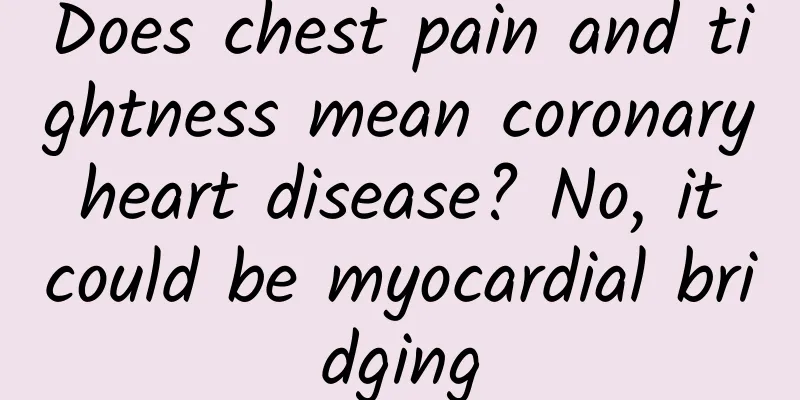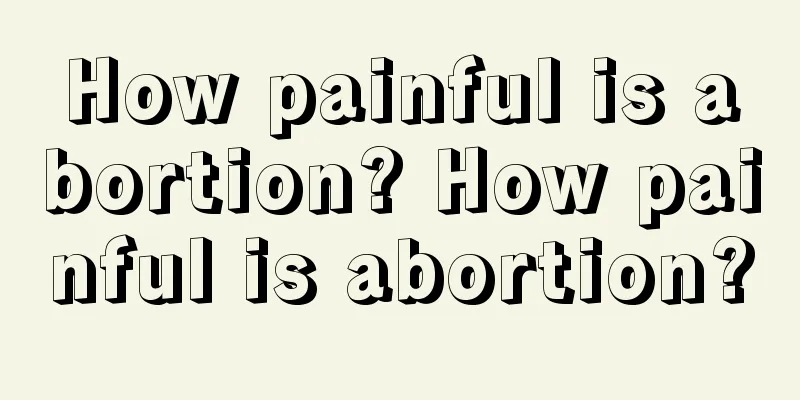Does chest pain and tightness mean coronary heart disease? No, it could be myocardial bridging

|
Author: Guo Yi, deputy chief physician, China Rehabilitation Research Center (Beijing Boai Hospital) Reviewer: Li Xuemei, Chief Physician, China Rehabilitation Research Center (Beijing Boai Hospital) Aunt Zhang often had chest tightness since she was young. Since she turned 50, the symptoms have become more frequent and aggravated, often accompanied by chest pain, especially when exercising or getting emotional. She thought she had "coronary heart disease" and went to the hospital for an electrocardiogram, which showed abnormal changes, proving her idea. However, after a systematic examination, it was found that Aunt Zhang's symptoms were caused by "myocardial bridge" rather than coronary heart disease. So what exactly is "myocardial bridge"? 1. What is myocardial bridge? Figure 1 Copyright image, no permission to reprint In fact, coronary myocardial bridge is a congenital abnormality of coronary artery development. Under normal circumstances, the main trunk of the coronary artery and its branches run in the subepicardial fat on the surface of the heart or in the deep surface of the epicardium. If a segment of the coronary artery is covered by the superficial myocardium and runs in the myocardium, then the myocardium covering the coronary artery is called a myocardial bridge. Usually, a mild myocardial bridge will not cause symptoms of myocardial ischemia or changes in the electrocardiogram. However, for thick and long myocardial bridges, the blood flow in the coronary artery is greatly affected, and angina pectoris and electrocardiogram changes may occur, especially during myocardial contraction, which is more obvious. The more the myocardium contracts and thickens, the more obvious the compression on the coronary artery, and the more severe the clinical symptoms. Possible symptoms and complications mainly include: angina pectoris, acute myocardial infarction, atrioventricular conduction block, heart failure, and even sudden death. Therefore, myocardial bridges with severe symptoms should be taken seriously. 2. How is myocardial bridge diagnosed? In addition to the clinical symptoms of Aunt Zhang mentioned above, common electrocardiogram abnormalities in patients with myocardial bridge include ST segment depression, flat or inverted T waves in precordial leads, etc. Myocardial bridges are divided into superficial and deep types. In addition to clinical symptoms and corresponding electrocardiogram changes, their diagnosis requires further coronary angiography and intracoronary Doppler ultrasound examination. At present, myocardial bridges can be diagnosed mainly based on coronary angiography. If typical signs of transient systolic stenosis are found, myocardial bridges can be confirmed. However, it should be noted that sometimes atherosclerotic lesions in the coronary artery segment involved in the myocardial bridge may mask this typical sign, and obvious signs of myocardial bridges will only appear after percutaneous transluminal coronary angioplasty (commonly known as balloon dilatation), which increases the difficulty of diagnosis. Usually, superficial myocardial bridges are difficult to detect because they are asymptomatic or have mild symptoms. Most of the myocardial bridges detected by coronary angiography are deep myocardial bridges. 3. How to treat myocardial bridge? 1) Superficial or mild myocardial bridge No special intervention is required. The occurrence of coronary atherosclerosis can be slowed down by adjusting eating habits and lifestyle. Keep a regular schedule, ensure adequate sleep, and avoid overwork. Stay optimistic, pay attention to emotional management, and avoid emotional excitement as much as possible to reduce myocardial oxygen consumption, reduce symptom onset, or alleviate the severity of symptoms. 2) For patients with severe myocardial bridge symptoms (1) Drug treatment is the first choice. Appropriate drugs should be selected under the guidance of a doctor and in full consideration of individual circumstances. ——Beta-blockers are the first choice drugs for treating myocardial bridge, such as metoprolol and bisoprolol. These drugs work by reducing pressure in the coronary arteries, prolonging myocardial relaxation, increasing blood flow reserves in the coronary arteries, and relieving symptoms of local myocardial ischemia caused by coronary artery compression. ——Calcium channel blockers, such as verapamil and diltiazem, can inhibit myocardial contraction and dilate coronary arteries, thereby alleviating clinical symptoms caused by myocardial bridge. It should be noted that patients who receive medication, in addition to taking medications at regular intervals and in fixed amounts as prescribed by their doctors, also need to undergo regular checkups to allow doctors to adjust treatment plans in a timely manner. Figure 2 Copyright image, no permission to reprint (2) Patients who are difficult to control with drug therapy should undergo surgical treatment, with the main surgical procedures being myocardial resection, coronary artery bypass grafting, etc. ——Myocardial bridge resection is suitable for superficial myocardial bridges. Under normal temperature general anesthesia, the myocardial bridge is found and removed, completely relieving its compression on the coronary artery and restoring distal coronary artery blood flow. However, few people undergo myocardial bridge resection alone, and it is often performed at the same time as coronary artery bypass grafting. ——Coronary artery bypass grafting is suitable for patients with deep myocardial bridge or combined arteriosclerotic stenosis. Coronary artery bypass grafting can be performed under normal temperature general anesthesia, normal temperature extracorporeal circulation or low temperature extracorporeal circulation. Usually, autologous great saphenous vein or internal thoracic artery can be selected as the graft material. Figure 3 Copyright image, no permission to reprint 4. What is the prognosis of myocardial bridge? Myocardial bridge is a disease caused by congenital developmental abnormalities that cannot heal itself and is difficult to completely cure. The main purpose of treatment is to alleviate symptoms and avoid serious complications. For example, Aunt Zhang at the beginning of this article adjusted her life and eating habits under the guidance of a doctor, paid attention to emotional management, and did not take any medication, and her symptoms were significantly relieved. However, for patients with severe symptoms, early intervention is needed to avoid serious complications, which can generally achieve better results. |
Recommend
Is salpingography effective?
If the fallopian tube is blocked, the main method...
How are you, stomach? A review of gastric cancer and nutritional care
Gastric cancer is one of the most common malignan...
What to do if the left fallopian tube is blocked
For women, if the left fallopian tube is blocked,...
Where does herpes appear in women?
Herpes is a very common disease in daily life. He...
Why are girls' nipples black?
Why are nipples gray and black? Normally, the col...
There are many kinds of bacteria hidden in the microwave oven, so regular cleaning is essential!
In modern society, microwave ovens have become an...
Can I eat barbecue when I have my period?
Many nutritionists call fried and grilled food wa...
What's wrong with the little girl's irregular menstruation?
Irregular menstruation is a problem faced by many...
Painless abortion recovery period
Due to the development of modern medical technolo...
What should I do if I have diarrhea during menstruation?
Many female friends will experience diarrhea duri...
What is the normal biparietal diameter at 36 weeks of pregnancy?
At 36 weeks of pregnancy, the baby will be back w...
Warning | These types of cancer may be passed on to the next generation!
Cancer is not only affected by diet and environme...
Symptoms of calcium deficiency in menopausal women
The human body contains more than 60 elements, in...
Which part should be hot-compressed for pelvic effusion?
Pelvic effusion can be divided into two types: ph...
Is the white spot on the episiotomy wound a sign of suppuration?
In order for new mothers to give birth smoothly, ...









